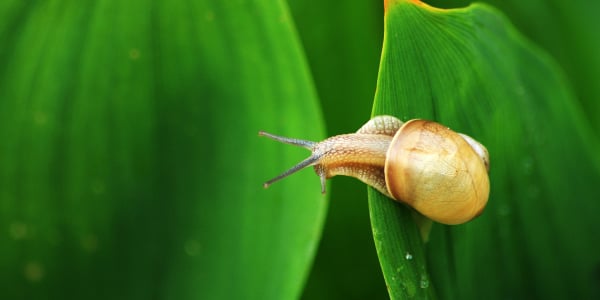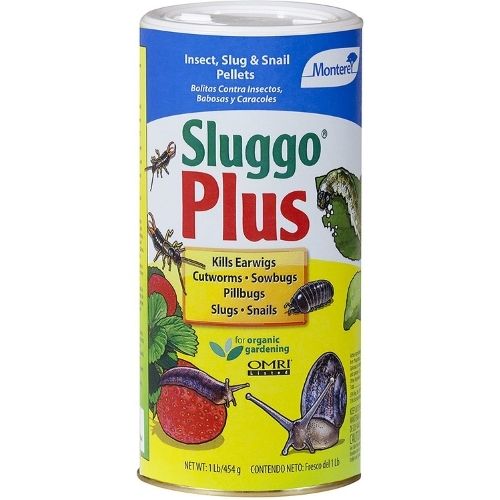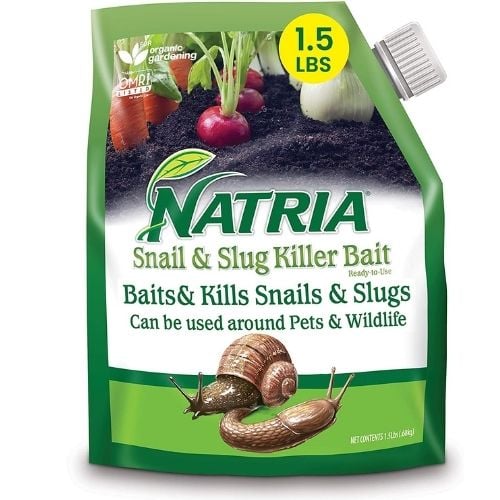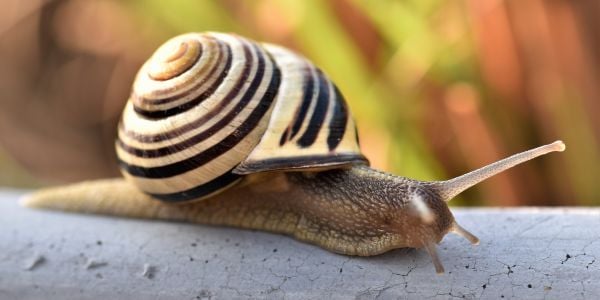 A beautiful garden full of big healthy plants and flowers melts the heart and soul of gardeners.
A beautiful garden full of big healthy plants and flowers melts the heart and soul of gardeners.
And nothing is more painful, except banging your pinky toe, than seeing your garden damaged by tiny little creatures that leave behind trails of slime.
But in the quest to remove destructive snails and slugs to maintain a beautiful and lush garden, we risk causing harm to our pets. Why?
The often-used compound that is meant to kill snails and slugs can also potentially kill our pets.
Most snail and slug poisons, which can come in a green or blue-colored liquid or granular form, contain a compound called metaldehyde, which is extremely poisonous to cats and dogs. Eating as little as 1 ounce of 3% metaldehyde can cause toxicity in a 10-pound dog.
Metaldehyde kills snails and slugs by causing them to dehydrate (it does this both by disturbing their ability to produce their protective mucus coating and by causing them to swell). In cats and dogs, it has a much different effect, which can be devastating and even fatal!
Skip to section:
Signs Your Pet May Have Eaten Snail and Slug Bait
ALERT: Any pet that has eaten a metaldehyde-based slug and snail poison should be brought for immediate veterinary evaluation, as time is of the essence when dealing with these poisonings.
Within one hour of ingestion, you will typically notice signs of toxicity:
- Vomiting is usually the first sign because the lining of the stomach becomes irritated by the metaldehyde. After this, there are different neurologic signs that can occur.
- Anxiety – racing heart and increased respiratory rate
- Increased drooling
- Walking stiffly or wobbly due to a lack of muscle control
- Hypersensitive to touch
- Nystagmus (when the eyes move rapidly back and forth) – especially for cats
- Muscle tremors that increase body temperature – this can lead to muscle death and organ failure
You may notice dark urine. This is due to the release of myoglobin from the death of muscle cells.
The progression of signs of toxicity progress for several hours following ingestion:
- Lack of energy
- Weakness
- Continuation of muscle tremors
- Seizures
- Loss of consciousness
Metaldehyde Is a Very Dangerous Poison for Dogs and Cats
Because many of these poison baits are flavored with bran and molasses to attract snails and slugs, cats and (especially) dogs are often attracted to them and eat them when given the chance. And sadly, if your pet survives their first bout of poisoning, they will happily seek out this bait again. Therefore, please find an alternative to eliminating snails and slugs in your garden.
In some states and countries, there exists regulatory actions requiring that these baits are unattractive to dogs.
Any pet that has eaten a metaldehyde-based slug and snail poison should be brought for immediate veterinary evaluation, as time is truly of the essence when dealing with these poisonings.
A “wait and see” approach is definitely not a good one, as the severity of the poisoning, the outcome, and the costs all get worse as time passes.
If you notice that your pet begins vomiting within an hour of being in your garden or known ingestion of a slug or snail. Not long after the vomiting starts, your pet will begin to show neurologic signs such as anxiety, abnormal walking, and tremors.
Is it Dangerous for a Pet to Eat a Snail or Slug?
As far as we know, eating (one snail or slug) isn't cause for concern, but it could be a concern if the snail had just consumed poisonous bait before being eaten. Typically, though, dogs and cats aren't interested in eating snails or slugs, but there are always those pets that are the exception to the rule.
NOTE: Even if you don’t use baits for snails and slugs, you must be aware that ingesting these slimy creatures can still pose potential harm. Slugs and snails can carry lungworm larvae. If you know your pet has a tendency to eat them, contact your veterinarian for advice.
Veterinary Care for a Pet Poisoned by Slug and Snail Bait?
When a pet has been or is suspected to be poisoned, time is of the essence. That is why when you arrive at the veterinary hospital, you will receive a barrage of questions, and the entire staff will start performing different tasks and treatments for your pet immediately.
While it all may seem overwhelming, your answers will help them determine a timeline as well as the possible cause of the symptoms. This will then guide the course of care.
There are many toxins that do not have specific treatments or antidotes. Methaldehyde poisoning (slug and snail bait) is one of them.
Following an initial assessment, the veterinary team will start supportive care, which includes intravenous fluids, medications to control symptoms, oxygen therapy, and possible cooling methods.
Vomiting will be induced if it has been within 2 hours of ingestion, but in some cases, it will be attempted if it has been within 4 hours.
Note: In some cases, depending on the toxin (corrosive chemical or petroleum-based products), inducing vomiting can cause more harm than good. Additionally, your veterinarian will not induce vomiting if your pet is unconscious.
Your pet may be sedated to have gastric lavage performed. This helps further remove toxins from the stomach. A tube will be passed into your pet’s stomach. Water will then be passed down the tube into the stomach.
Once filled, the stomach will be gently compressed to remove the water. When all the contaminants appear to be removed, your pet will generally be given activated charcoal and cathartics to assist in further decontamination.
Depending on your pet’s presenting symptoms and response to treatment, they may need to be hospitalized for a few days for continued supportive care.
To see all this in action, watch the video below. It's not graphic, but it is disturbing to see the puppy in distress.
Getting Rid of Snails and Slugs While Keeping Your Pets Safe
If your garden is plagued with snails and slugs, there are safer ways to keep them out of your garden or get rid of them entirely.
How to Deter Slugs & Snails
- Surround your plants with a layer of broken shells, diatomaceous earth, lava rock, or another “rough” material. These surfaces will deter slugs and snails and will fatally injure those who decide to make the trek.
- Planting lavender, rosemary, or mint has been shown to deter slugs and snails due to their smell.
- Coffee grounds scattered on the ground around plants deter snails and slugs. Only use in moderation, not excessively.
A ’natural’ product that is often talked about is garlic oils and products. Garlic is toxic to both dogs and cats. It tastes good to most dogs, and some cats will even eat it. It can result in liver failure as well as a form of anemia. Its use is not recommended.
- Use plants with waxy, glossy, thick, leathery, or hairy leaves. Snails and slugs do not like these types of plants. Just be sure the plants you select are not toxic to your pets.
- Place copper mesh around your plants to discourage slugs and snails in your garden.
- Keep soggy leaves away from plants. Snails and slugs like to hide in moist, dark places during the day. This includes places like leaves, mulch, and pots.
- Mulch later in the season, early summer instead of spring, so that the soil and air are drier. Note: don't use cocoa mulch, as it's toxic to dogs and cats if they eat it.
More Natural Ways to Get Rid of Snails and Slugs
- Place tuna cans or yogurt cups filled with beer in your garden. The snails and slugs will be attracted to the beer, fall into the can, and drown. Warning: Just be very careful not to let your pets or children into the garden and around the beer! Both dogs and cats have a lower tolerance for alcohol than most humans. Beer can make them quite ill.
- You can trap them since they like to hide and lay their eggs in the same place. Put our moistened newspaper or damp boards. Once they gather under them, you can throw out the paper or scrape off the board.
Pet-Safer Poisons to Get Rid of Snails and Slugs
- If you want or need to use poison, choose the pet-SAFER baits, which contain iron phosphate. These iron-phosphate-containing baits have been shown to be as effective at killing snails and slugs, yet they are safer than the traditional metaldehyde-containing baits.
NOTE: It’s important to note that they are still dangerous for cats and dogs when eaten, it just takes quite a bit more to cause problems, and the problems they cause aren’t nearly as widespread and devastating as those caused by metaldehyde. Hence “pet-SAFER,” rather than “pet-SAFE!”


Best wishes for a beautiful, lush garden that is pet safe and free of snails and slugs.




